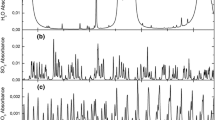Summary
A system based on the combination of flame-ionization (FID) and flame-photometric (FPD) detectors was developed which has a high sensitivity in the analysis of compounds containing sulphur, chlorine, phosphorus, and nitrogen in CN-group. The wavelengths of maximum absorption by these heteroatoms were measured and the reasons for non-selectivity of previously described systems were explained. The minimum detectible amounts of the system described were: 10−6 g of Cl and N and 10−7 g of S.
Zusammenfassung
Es wurde eine hoch selektive Kombination von FI-und FP-Detektoren unter den für die Flammenionisationsdetektoren üblichen Bedingungen zur Analyse von Verbindungen eingesetzt, die in ihrem Molekül Schwefel, Chlor, Phosphor und Stickstoff in der Form einer CN-Gruppe enthalten. Die Wellenlängen der Absorptionsmaxima der erwähnten Heteroatome wurden gemessen und der Grund der Unselektivität bisheriger Lösungen geklärt. Mittels der ausgearbeiteten apparativen Lösung wurden 10−6g Cl und N, und 10−7g S als niedrigste Substanzmenge gemessen.
Résumé
Un dispositif basé sur la combinaison d'un détecteur à ionisation de flamme (DIF) et d'un détecteur photométrique de flamme (DPF) est mis au point; il est très sensible pour les composés contenant du soufre, du chlore, du phosphore et de l'azote (groupes CN). La longueur d'onde du maximum d'adsorption de ces hétéroatomes est mesurée et les causes de non-sélectivité des dispositifs précédemment décrits sont expliquées. La quantité minimale détectable, avec le dispositif décrit, est de 10−6 g. pour le chlore et l'azote, et de 10−7g. pour le soufre.
Similar content being viewed by others
References
Bowman, M. C., Beroza, M.: J. Chromatog. Science7, 484 (1969).
Brody, S. S., Chaney, J. E.: J. Gas Chromatog.4, 42 (1966).
Bowman, M. C., Beroza, M.: Anal. Chem.,40, 1448 (1968).
Crider, W. L., Anal. Chem.41, 534 (1969).
Mulliken, R. S.: Phys. Rev.26, 1 (1925).
Ritschl, R.: Z. Physik42, 172 (1927).
Huyten, F. H., Rijnders, G. W. A.: Z. Anal. Chem.205, 244 (1964).
Author information
Authors and Affiliations
Rights and permissions
About this article
Cite this article
Ševčík, J. Selective detection of sulphur, chlorine, and nitrogen with help of the combination of flame-ionization and flame-photometric detectors. Chromatographia 4, 195–197 (1971). https://doi.org/10.1007/BF02281051
Received:
Accepted:
Issue Date:
DOI: https://doi.org/10.1007/BF02281051




